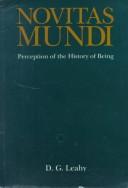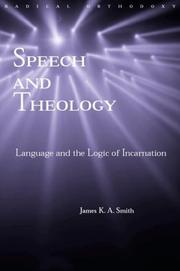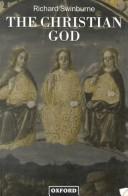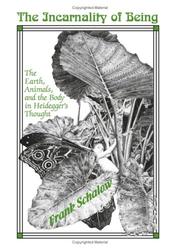| Listing 1 - 10 of 19 | << page >> |
Sort by
|
Book
ISBN: 1281341401 9786611341404 0191547875 9780191547874 9781281341402 0199203113 9780199203116 138303429X Year: 2008 Publisher: Oxford New York Oxford University Press
Abstract | Keywords | Export | Availability | Bookmark
 Loading...
Loading...Choose an application
- Reference Manager
- EndNote
- RefWorks (Direct export to RefWorks)
Richard Swinburne argues compellingly that if there is a God, then the main doctrines which the Christian Church teaches about God are very probably true. In particular, he shows that there is strong philosophical support for the belief that Jesus, while remaining God, acquired a human nature and lived on earth for 30 years as a human being.
Incarnation --- Kenosis (Theology) --- Biblical teaching. --- Biblical teaching --- Philosophy. --- Jesus Christ --- Person and offices.
Book
ISBN: 1315569132 1317174933 1317174941 1472413717 9781472413710 9781299925250 1299925251 1472413725 9781472413727 9781472413697 1472413695 9781472413703 1472413709 9781315569130 9781317174929 9781317174936 Year: 2013 Publisher: Farnham Ashgate Publishing Ltd
Abstract | Keywords | Export | Availability | Bookmark
 Loading...
Loading...Choose an application
- Reference Manager
- EndNote
- RefWorks (Direct export to RefWorks)
The central contention of Christian faith is that in the incarnation the eternal Word or Logos of God himself has taken flesh, so becoming for us the image of the invisible God. Our humanity itself is lived out in a constant toing and froing between materiality and immateriality.Approaching different aspects of two distinct movements between the image and the word, in the incarnation and in the dynamics of human existence itself, Trevor Hart presents a clearer understanding of each and explores the juxtapositions with the other.
Incarnation. --- Imagination --- Language and languages --- Theology in literature. --- Christianity and language --- Kenosis (Theology) --- Religious aspects --- Christianity.

ISBN: 0585044708 9780585044705 0791421376 0791421384 1438410263 Year: 1994 Publisher: Albany State University of New York Press
Abstract | Keywords | Export | Availability | Bookmark
 Loading...
Loading...Choose an application
- Reference Manager
- EndNote
- RefWorks (Direct export to RefWorks)
Ontology --- History --- Incarnation --- Philosophy & Religion --- Philosophy --- Kenosis (Theology) --- Annals --- Auxiliary sciences of history --- Being --- Metaphysics --- Necessity (Philosophy) --- Substance (Philosophy) --- Philosophy.
Book
ISBN: 9781438472171 9781438472188 143847217X 1438472188 Year: 2018 Publisher: Albany
Abstract | Keywords | Export | Availability | Bookmark
 Loading...
Loading...Choose an application
- Reference Manager
- EndNote
- RefWorks (Direct export to RefWorks)
What is scripture and how does it function ? Is there a “scientific” way to understand its meaning ? In answer, Adam Wells proposes a phenomenological approach to scripture that radicalizes both phenomenology and its relation to Christianity. By reading the “kenōsis hymn” (Philippians 2:5–11) alongside the work of Edmund Husserl, Wells develops a kenotic reduction that rehabilitates the Husserlian idea of “absolute science” while also disclosing the radical philosophical implications of Paul’s “new creation.” More broadly, The Manifest and the Revealed pushes the fields of phenomenology and biblical studies forward. The turn to scripture, as a source for theological and philosophical reflection, marks an important advance for the recent “theological turn” in phenomenology. At the same time, by bringing to light the incredible complexity of scripture, phenomenology provides a way for contemporary biblical studies to exceed its own limits. Wells demonstrates how phenomenology and scripture ultimately illuminate one another in profound and surprising ways
Phenomenology --- Philosophical theology --- Incarnation --- Hermeneutics --- Bible --- Phenomenology. --- Incarnation. --- Philosophical theology. --- Hermeneutics. --- Theology, Philosophical --- Philosophy and religion --- Theology, Doctrinal --- Philosophy, Modern --- Kenosis (Theology)
Book
ISSN: 0920623X ISBN: 9789004290204 9004290206 9789004290815 9004290818 Year: 2015 Volume: 130 Publisher: Leiden Boston
Abstract | Keywords | Export | Availability | Bookmark
 Loading...
Loading...Choose an application
- Reference Manager
- EndNote
- RefWorks (Direct export to RefWorks)
In Physicalist Soteriology in Hilary of Poitiers , Ellen Scully presents Hilary as a representative of the “mystical” or “physical” trajectory of patristic soteriology most often associated with the Greek fathers. Scully shows that Hilary’s physicalism is unique, both in its Latin non-Platonic provenance and its conceptual foundation, namely that the incarnation has salvific effects for all humanity because Christ’s body contains every human individual. Hilary’s soteriological conviction that all humans are present in Christ’s body has theological ramifications that expand beyond soteriology to include christology, eschatology, ecclesiology, and Trinitarian theology. In detailing these ramifications, Scully illumines the pervasive centrality of physicalism in Hilary’s theology while correcting standard soteriological presentations of physicalism as an exclusively Greek phenomenon.
Salvation --- Christianity --- History of doctrines --- Hilary, --- Incarnation --- 276 =71 HILARIUS PICTAVIENSIS --- Kenosis (Theology) --- Latijnse patrologie--HILARIUS PICTAVIENSIS --- Hilaire, --- Hilario, --- Hilarius, --- Ilario, --- Athanasius, --- Pseudo-Hilarius --- Salvation - Christianity - History of doctrines - Early church, ca 30-600 --- Hilary, - Saint, Bishop of Poitiers, - -367?
Book
ISBN: 2878548639 2878544951 Year: 2018 Publisher: Paris : Presses Sorbonne Nouvelle,
Abstract | Keywords | Export | Availability | Bookmark
 Loading...
Loading...Choose an application
- Reference Manager
- EndNote
- RefWorks (Direct export to RefWorks)
Iconoclasmes, écriture figurée et théologie de l’Incarnation chez les poètes métaphysiques. Le cas de George Herbert. Cet ouvrage propose une nouvelle lecture de l'ouvre poétique de George Herbert (1593-1633), poète « métaphysique » et pasteur anglican. Il est replacé dans le contexte de l'iconoclasme anglais des 16e et 17e siècles, et dans celui de la crise plus fondamentale de l'image qui obsède l'âge baroque en Europe. La rhétorique et l'imaginaire iconoclastes sont au fondement du projet littéraire et religieux de Herbert, qui cherche à convertir et à purifier la poésie. Il contribue ainsi à façonner une nouvelle langue poétique et une pensée analogique paradoxalement fondées sur la résistance de l'image. Il s'agit de restaurer cette ressemblance de l'homme à Dieu qui semble avoir été perdue. La poésie aura pour tâche de la reconstruire intérieurement par une poétique efficace, dont le modèle absolu est la théologie de l'Incarnation, elle-même théologie de l'image.
Christian poetry, English --- Christianity and literature --- Reformation --- Iconoclasm --- Iconoclasm in literature. --- Incarnation --- History and criticism. --- History --- History of doctrines --- Herbert, George, --- Criticism and interpretation. --- Kenosis (Theology) --- Idols and images --- English Reformation --- Worship --- Harbert, George, --- métaphysique --- George Herbert --- incarnation --- iconoclasme --- théologie
Book
ISBN: 1783596635 9781783596638 9781783596621 1783596627 Year: 2019 Publisher: London
Abstract | Keywords | Export | Availability | Bookmark
 Loading...
Loading...Choose an application
- Reference Manager
- EndNote
- RefWorks (Direct export to RefWorks)
Pastoral theology. --- Church work. --- Incarnation. --- Kenosis (Theology) --- Church work with adults --- Institutional church --- Ministry --- Theology, Practical --- Care of souls --- Cure of souls --- Pastoral office and work --- Theology, Pastoral --- Church work --- Pastoral care

ISBN: 0415276969 9780415276962 9780415276955 0415276950 0203995279 9780203995273 0203463242 9780203463246 113447394X 1283642220 1280112352 1134473931 9781134473939 9781134473946 9781283642224 9781280112355 Year: 2002 Publisher: London ; New York : Routledge,
Abstract | Keywords | Export | Availability | Bookmark
 Loading...
Loading...Choose an application
- Reference Manager
- EndNote
- RefWorks (Direct export to RefWorks)
God is infinite, but language finite; thus speech would seem to condemn Him to finitude. In speaking of God, would the theologian violate divine transcendence by reducing God to immanence, or choose, rather, to remain silent? At stake in this argument is a core problem of the conditions of divine revelation. How, in terms of language and the limitations of human understanding, can transcendence ever be made known? Does its very appearance not undermine its transcendence, its condition of unknowability?Speech and Theology posits that the paradigm for the encounter between the material and the divine, or the immanent and transcendent, is found in the Incarnation: God's voluntary self-immersion in the human world as an expression of His love for His creation. By this key act of grace, hinged upon Christs condescension to human finitude, philosophy acquires the means not simply to speak of perfection, which is to speak theologically, but to bridge the gap between word and thing in general sense.
Christianity --- Incarnation. --- Language and languages --- Philosophy. --- Religious aspects --- Christianity. --- 21*015 --- Theologie en taal --- 21*015 Theologie en taal --- Incarnation --- Foreign languages --- Languages --- Anthropology --- Communication --- Ethnology --- Information theory --- Meaning (Psychology) --- Philology --- Linguistics --- Kenosis (Theology) --- Philosophy --- Religious aspects&delete& --- Christianity and language --- Christianity - Philosophy. --- Language and languages - Religious aspects - Christianity.

ISBN: 0198235135 0198235127 0191598577 9786611980849 0191518905 1281980846 0585128200 9780191518904 9780191598579 9780198235132 9780198235125 Year: 1994 Publisher: Oxford [England]
Abstract | Keywords | Export | Availability | Bookmark
 Loading...
Loading...Choose an application
- Reference Manager
- EndNote
- RefWorks (Direct export to RefWorks)
This book is about what it is for there to be a God, and why we might suppose that God to be the traditional Christian God. It analyses the metaphysical categories needed for this purpose and sets out ways in which the doctrine that there is a divine individual (an individual with the traditional divine properties) can be developed.
God (Christianity) --- Incarnation --- Trinity --- 231 --- Theology, Doctrinal --- Triads (Philosophy) --- Appropriation (Christian theology) --- Godhead (Mormon theology) --- Holy Spirit --- Trinities --- Tritheism --- Kenosis (Theology) --- Christianity --- 231 God. De Deo uno et trino:--dogmatisch --- God. De Deo uno et trino:--dogmatisch --- God. --- Trinity. --- Incarnation. --- Metaphysics --- Misotheism --- Theism

ISBN: 0791481867 1429413522 9781429413527 079146735X 9780791467350 9780791481868 Year: 2006 Publisher: Albany
Abstract | Keywords | Export | Availability | Bookmark
 Loading...
Loading...Choose an application
- Reference Manager
- EndNote
- RefWorks (Direct export to RefWorks)
The Incarnality of Being addresses Martin Heidegger's tendency to neglect the problem of the body, an omission that is further reflected in the field of Heidegger scholarship. By addressing the corporeal dimension of human existence, author Frank Schalow uncovers Heidegger's concern for the materiality of the world. This allows for the ecological implications of Heidegger's thought to emerge, specifically, the kinship between humans and animals and the mutual interest each has for preserving the environment and the earth. By advancing the theme of the "incarnality of being," Schalow brings Heidegger's thinking to bear on various provocative questions concerning contemporary philosophy: sexuality, the intersection of human and animal life, the precarious future of the earth we inhabit, and the significance that reclaiming our embodiment has upon ethics and politics.
Incarnation. --- Kenosis (Theology) --- Heidegger, Martin, --- Khaĭdegger, Martin, --- Haĭdegger, Martin, --- Hīdajar, Mārtin, --- Hai-te-ko, --- Haidegŏ, --- Chaitenger, Martinos, --- Chaitenker, Martinos, --- Chaintenger, Martin, --- Khaĭdeger, Martin, --- Hai-te-ko-erh, --- Haideger, Marṭinn, --- Heidegger, M. --- Haideger, Martin, --- Hajdeger, Martin, --- הייגדר, מרתין --- היידגר, מרטין --- היידגר, מרטין, --- 海德格尔, --- Chaintenker, Martin, --- Hāydigir, Mārtīn, --- Hīdigir, Mārtīn, --- هاىدگر, مارتين, --- هىدگر, مارتين,
| Listing 1 - 10 of 19 | << page >> |
Sort by
|

 Search
Search Feedback
Feedback About UniCat
About UniCat  Help
Help News
News